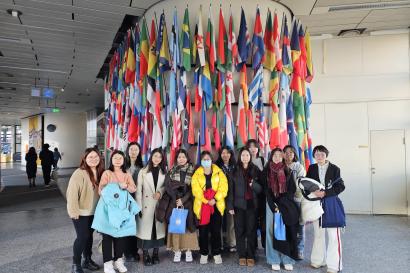China has plans. Big plans. When President Xi Jinping announced the Belt and Road Initiative (BRI) in 2013,[1] he presented a vision of a China with far-reaching outward-looking economic and political influence, stretching from East Asia to Europe and beyond.
The BRI, aka the New Silk Road, incorporates a bold strategic education plan that places China as an education and research powerhouse by 2035. It’s a plan that, by interacting with it, Western universities and academia at large can benefit from, too.
What is the BRI academic strategy?
Domestically, the Chinese government has targeted tertiary education improvement as a primary objective on this march to academic prominence. “In 2019, the Chinese State Council published […] China’s Education Modernization 2035 Plan and the Implementation Plan for Accelerating Education Modernization (2018-2022), aimed at substantially modernizing China’s education system by 2035.[2]”
In its 2020 analysis, the Australian government noted China’s clear commitment to “continued reform in and advancement of China’s education sector,[3]” with a three-pronged approach that targets discipline development, entrepreneurship/employment for undergraduates, and research and academic development for postgraduates.
In their 2021 paper in Beijing International Review of Education, "Understanding Education on China’s Belt and Road Initiative: A Cultural Political Economy Approach," Xu lauds education as a large step towards international collaboration.
“Education has been designated as a crucial component in the BRI imaginary to facilitate BRI materialization. Education should be understood as a complex and evolving entity that is rationalized and shaped by the wider interactive process involving a combination of cultural, political, and economic factors and dynamics in its formation.[4]”
“China’s policy preference towards international education has been consistent with its attitudes towards globalization. The […] Chinese government has made explicit commitment regarding further opening [the] international education sector, boosting scholarship provision for overseas students, and encouraging transnational academic collaboration.[5]”
While “the number of students leaving China to study overseas annually more than tripled over the past decade, with more than 700,000 leaving China’s shores in 2019,[6]” the pandemic put some of those plans on hold. The drive to 2035, however, pushes forward. Internationally, China has growing influence over research and development, too, by investing in trade and infrastructure in strategic countries along the New Silk Road. As the Australian government also noted: China’s “international collaboration goals appear to be heavily focused on the Belt and Road Initiative (BRI).[7]”
“To date,” say Chatzky and McBride for the Council on Foreign Relations, more than 60 countries—accounting for two-thirds of the world’s population—have signed on to projects or indicated an interest in doing so.
And THE reported in 2019[8] that “nine nations increased their collaborative research with China by more than 100 per cent in the period 2013-17. All but one (Chile) were along the Belt and Road route.[9]”
What does BRI mean for international universities?
The United States’ tertiary institutions are in a fantastic position to craft a cooperative future with Asia by developing study-abroad experiences that champion the cultural exchange and profound understanding of ‘other,’ both key elements of the educational development plans.
What makes great course opportunities for Chinese students studying abroad?
China has prioritized promoting international undergraduate experiences and postgraduate collaboration. With China’s borders closed and unlikely to reopen until 2022,[10] virtual online programs are the best way for Chinese students to be part of a global academic community.
Even when travel restrictions ease, China is keen to keep its talent close. Chinese universities rank higher domestically by just sending students abroad for a few weeks, maybe a season, to broaden their horizons, gain a better understanding of ‘other,’ and build cultural bridges. “Education,” you see, “is to be conceptualized as part of the bigger social policy package aimed at transforming the wider outlook of Chinese society, reflecting the transformative nature of the Chinese state in recent years.[11]”
In creating programs to appeal to Chinese students and ambassadors that advise them, there are a few sure-fire elements host universities should incorporate, both while borders are closed and when full global mobility returns:
- Guest lectures with international industry leaders
- Subject-relevant field experiences
- High-level industry visits
- Academically rigorous teaching programs
- Learning alongside host university students
- Credit to transfer to the home university
- Short summer or semester-long courses over year-long courses
- Language-certificate courses and language support
- Student collaboration and mentoring
- Concurrent online versions of the course with similar cultural opportunities
Essentially, the more opportunity available for cross-cultural engagement with people from different culture and civilizations, the better.
As for which courses to focus on, analysis from Australia identified a hard push to make much greater use of “the internet, big data, and Artificial Intelligence (AI) […] in education, with greater variety of educational resources and services. China is seeking to perfect online education delivery,[12]” to accommodate the 2035 Plan for “educational reform in the information age.”
By building intelligent campuses and using technology as a tool for teaching, learning, and resource sharing, China hopes to accelerate learning for the “232 million online education users.[13]”
As a result, a government-approved “AI technology major had the largest number of new approvals—more than 100 Chinese higher education institutions were approved to set up this major at undergraduate level.[14]”
Other popular courses for Chinese students include[15]
- Math
- Computer science
- Engineering
- Business management
Even as virtual courses, these options are significantly appealing to Chinese students in the short and medium term as they build internationalization at home. By tapping those interests and acknowledging that your program needs to reach beyond the subject and dig deeper into cultural experience, your department and university can continue to forge powerful connections and align with China’s policy goals of a BRI-rich future.
[4, 5] Xu, B. (2021). Understanding Education on China’s Belt and Road Initiative: A Cultural Political Economy Approach, Beijing International Review of Education, 3(1), 56-71. doi: https://doi.org/10.1163/25902539-0301000
[6] https://www.timeshighereducation.com/campus/after-gold-rush-how-respond-chinese-student-downswing
[8] https://www.timeshighereducation.com/news/chinas-belt-and-road-initiative-boosting-academic-links
[9] https://www.cfr.org/backgrounder/chinas-massive-belt-and-road-initiative
[10] https://www.timeshighereducation.com/news/china-and-japan-keep-borders-shut-new-term-starts
[11] https://brill.com/view/journals/bire/3/1/article-p56_56.xml
[13] http://www.cac.gov.cn/2019-08/30/c_1124938750.htm
[15] https://www.statista.com/statistics/372909/chinese-students-in-the-us-by-subject/




